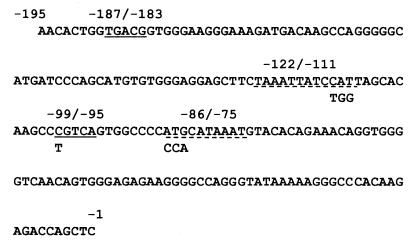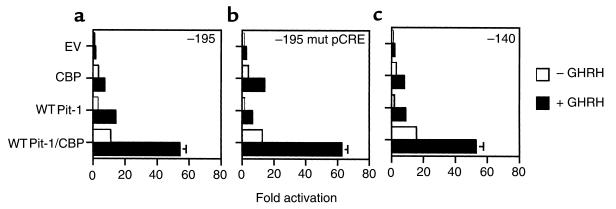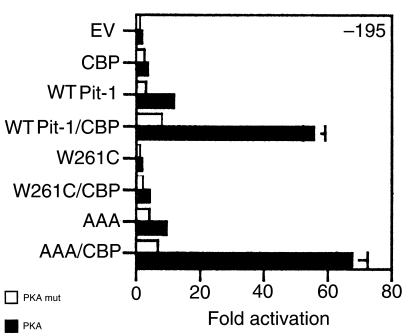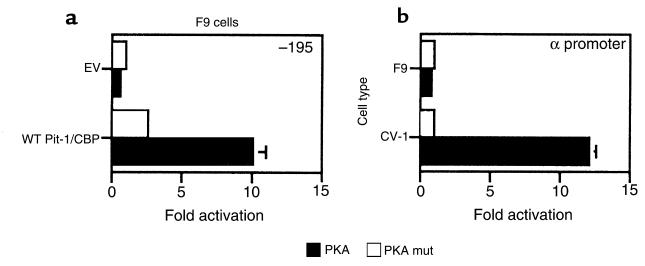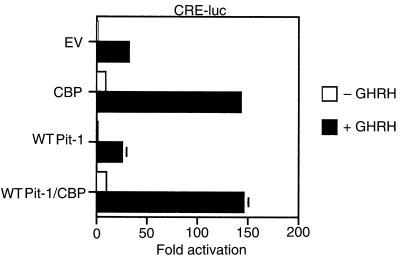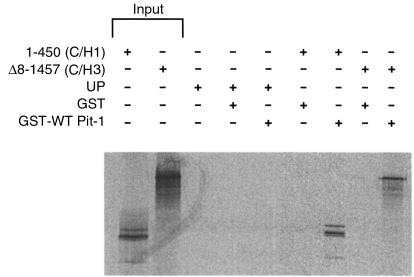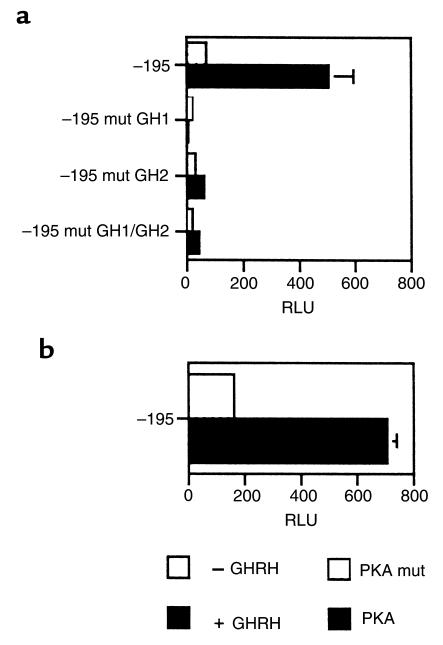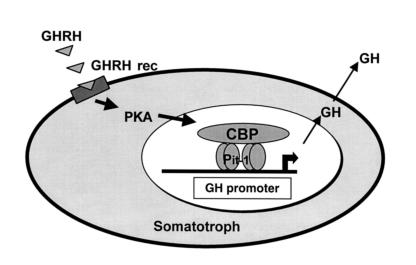Abstract
Hypothalamic growth hormone–releasing hormone (GHRH) stimulates growth hormone (GH) gene expression in anterior pituitary somatotrophs by binding to the GHRH receptor, a G-protein–coupled transmembrane receptor, and by mediating a cAMP-mediated protein kinase A (PKA) signal-transduction pathway. Two nonclassical cAMP-response element motifs (CGTCA) are located at nucleotides –187/–183 (distal cAMP-response element; dCRE) and –99/–95 (proximal cAMP-response element; pCRE) of the human GH promoter and are required for cAMP responsiveness, along with the pituitary-specific transcription factor Pit-1 (official nomenclature, POU1F1). Although a role for cAMP-response element binding protein (CREB) in GH stimulation by PKA has been suggested, it is unclear how the effect may be mediated. CREB binding protein (CBP) is a nuclear cofactor named for its ability to bind CREB. However, CBP also binds other nuclear proteins. We determined that CBP interacts with Pit-1 and is a cofactor for Pit-1–dependent activation of the human GH promoter. This pathway appears to be independent of CREB, with CPB being the likely target of phosphorylation by PKA.
Introduction
Pit-1 is a member of a family (POU) of transcription factors regulating mammalian development. The expression of both the human (h) and rat (r) growth hormone (GH) genes is controlled by a pituitary-specific promoter that contains 2 binding sites for Pit-1 (1). Both sites are essential for GH promoter activity in vivo and in vitro (2). Pit-1 contains 2 protein domains — POU-specific and POU-homeo — that are necessary for high-affinity DNA binding on the GH gene (1, 3). When bound to DNA, Pit-1 activates GH gene expression, in part, through an NH2-terminal transactivation domain rich in hydroxylated amino acid residues (4, 5). The level of Pit-1 in pituitary cell lines is sufficient to activate the minimal elements in the GH promoter necessary for cell-specific expression of this gene (3), but Pit-1 alone is not sufficient for regulated GH gene expression (6–11).
The GH gene is regulated by growth hormone–releasing hormone (GHRH) in a process whereby elevated intracellular cAMP levels in normal pituitary cells consequently activate protein kinase A (PKA) (12, 13). Although it has been suggested that Pit-1 is involved in the cAMP regulation of the rGH promoter (9, 14, 15), it is not clear how Pit-1 mediates the effects of cAMP. For example, the cellular content of Pit-1 is not increased by PKA (16). Changes in the phosphorylation state of Pit-1 by either PKA or protein kinase C (PKC) might mediate the increase in gene expression. Three phosphorylation sites are present on Pit-1: Ser 115, Thr 219, and Thr 220 (16, 17). PKA, PKC, and a mitotic kinase have all been shown to phosphorylate Pit-1 at Thr 220 in vitro, and phosphorylation at this site has been shown to inhibit DNA binding (16, 17).
The hGH promoter contains 2 core cAMP-response elements (CREs) consisting of CGTCA motifs of the palindromic consensus sequence TGAC-GTCA: a distal (d) CRE located at –187/–183 and a proximal (p) CRE located at –99/–95 (18), both located near the distal Pit-1 binding site at –123/–112. All 3 sites are required for cAMP responsiveness, as mutations of these sites result in decreased forskolin induction (18). These CREs are also present in the chinook salmon (19) and the rainbow trout (20) and function in a similar manner. The proteins binding to the CREs in the hGH promoter are related to cAMP-response element binding protein (CREB)/activating transcription factor-I (ATF-1) but direct CREB or ATF-1 binding to these response elements has not been proved (18). In addition, the rGH promoter lacks both CREs but has been reported to be stimulated by cAMP (21, 22). Thus, the mechanism responsible for synergistic hormonal response on the GH gene is unknown.
A protein has been isolated that bound to CREB in a phosphorylation-dependent manner and activated gene expression in response to PKA. This nuclear protein, termed CREB binding protein (CBP), is 270 kDa in molecular size and closely related to another coactivator, P300 (23–25). CBP acts by binding to phosphorylated CREB (PKA-dependent) and activating gene expression (25–29). CBP binds to CREB through an NH2-terminal domain (30) and functions to activate transcription through a more COOH-terminal domain, which is proposed to activate histone acetyltransferases (31, 32) and displace nucleosomes, as well as to recruit RNA polymerase II to the transcription complex (33) in a process requiring RNA helicase A (34). The COOH-terminus of CBP (amino acids 1678–2441) has been shown to mediate PKA induction when fused to the GAL4 DNA binding domain on a GAL reporter (25). CBP not only acts through CREB, but also interacts with various kinases, mitogens, and nuclear hormone receptors (NHRs), including c-Jun (26, 35), c-Fos (36), c-Myb, v-Myb (37, 38), Sap-1a (39), Stat2 (40), MyoD (41), pp90Rsk (42), p45/NF-E2 (43), and the TR, RAR, and RXR receptors (44, 45). CBP is also controlled by nuclear calcium and CaM kinase IV (46). CBP can be phosphorylated within its COOH-terminal glutamine-rich region by extracellular signal-related kinase–subclass (ERK-subclass) mitogen-activated protein kinases (MAPKs), which can enhance CBP’s transactivation potential (39). Kamei et al. (45) proposed, based on multiple interactions with different nuclear proteins at different CBP domains, that CBP may function as an integrator of many regulatory pathways. Because the hGH gene is under control of some of the same pathways known to impinge on CBP, a role for CBP in Pit-1 regulation of hGH gene expression was investigated.
In this report, we demonstrate that CBP acts as a cofactor for Pit-1–dependent activation of the hGH promoter by the GHRH signaling pathway and PKA. Although the hGH promoter contains imperfect CREs that may be targets for phosphorylated CREB, the CBP-mediated Pit-1–dependent activation is shown to be independent of CREB.
Methods
Transfection constructs.
Luciferase reporter constructs contain either 195 or 140 bp of 5′-flanking DNA of the hGH promoter with or without mutations of the proximal Pit-1 binding site GH1 (mut GH1), the distal Pit-1 binding site GH2 (mut GH2), or the pCRE (mut pCRE) (Figure 1); 846 bp of 5′-flanking DNA of the human common glycoprotein α-subunit promoter; or 4 copies of a consensus CRE upstream of TK (Stratagene, La Jolla, California, USA). All Pit-1 and CBP constructs were cloned into the SV-40 expression construct pSG5. The Pit-1 binding mutant W261C and the Pit-1 phosphorylation mutant S115A/T119A/T220 (AAA) were created using site-directed mutagenesis (CLONTECH Laboratories Inc., Palo Alto, California, USA) of the original wild-type (WT) Pit-1. CBP deletion mutants were made using restriction enzyme digestion and removal of WT mouse CBP as described previously (47). hGHRH receptor was cloned in pGEM7z. WT and mutant PKA catalytic subunit (48) were cloned in an RSV expression vector.
Figure 1.
Proximal end (–195/–1) of the hGH promoter. The 2 core CREs at –187/–183 and –99/–95 are underlined with a solid line, and the 2 Pit-1 binding sites at –122/–111 and –86/–75 are underlined with a dashed line. Nucleotides altered for mutational analysis are indicated below each site.
Transfection assays.
Experiments were carried out in triplicate in 24-well plates. A calcium-phosphate precipitation technique (Specialty Media Inc., Lavallette, New Jersey, USA) was used in CV-1 cells (Pit-1–deficient) or in F9 cells (CREB-deficient) as indicated. A total of 0.15 μg of pSG5 Pit-1 expression construct, 0.2 μg of pA3-luc reporter construct, 1 μg of pSG5 WT CBP expression construct (amount adjusted for size of deletion mutants), 0.1 μg of WT or mutant catalytic subunit PKA, and 0.0125 μg hGHRH receptor were transfected per well. All transfections were balanced for the same amount of expression vector using empty vector (EV) as needed. For GHRH stimulation, 1 nM hGHRH(1-29)-NH2 dissolved in BSA was added to the media for 6 hours, or with BSA as a control. Luciferase activity was measured 48 hours after transfection.
GST assays.
WT Pit-1 protein was fused in-frame with glutathione-S-transferase (GST) in pGEX4T2 vector (Pharmacia Biotech Inc., Piscataway, New Jersey, USA). Recombinant proteins were synthesized in JM109 bacteria and purified on glutathione-Sepharose resin under nondenaturing conditions. GST proteins were analyzed on SDS-PAGE before use in the assay. 35S-labeled CBP deletion construct (1–450 or Δ8–1457) was generated in an in vitro transcription/translation system (TNT; Promega Corp., Madison, Wisconsin, USA) and exposed to the indicated GST protein. After extensive washing with NET (150 mM NaCl, 1 mM EDTA, 0.5% NP-40) at 4°C, the proteins trapped by the resin were resolved on SDS-PAGE and detected by autoradiography.
Results
Classically, on genes containing CREs, CREB binds as a homodimer and, after phosphorylation by PKA, binds to CBP (23, 25). Because the hGH promoter contains 2 CREs and 2 Pit-1 binding sites, we wanted to determine whether CBP acts as a cofactor for Pit-1–dependent regulation of the hGH gene. Cotransfection assays of the proximal GH promoter reporter were performed in a Pit-1–deficient cell line, CV-1. A total of 195 bp of the hGH promoter was chosen for these studies (because it contains both nonclassical CREs and both Pit-1 binding sites) and was fused to the luciferase reporter gene (Figure 1). The rat Pit-1 cDNA was chosen because rat Pit-1 and its isoforms are much better characterized than is human Pit-1, and because rat Pit-1 and human Pit-1 are virtually identical at the amino acid level. hGHRH(1-29)-NH2 was used in these studies, as its ability to stimulate GH secretion is well documented (49).
Figure 2 illustrates the effects of Pit-1 and CBP on hGH gene activation. After stimulation by hGHRH, which required cotransfection of hGHRH receptor (data not shown), the hGH promoter was activated 7-fold by CBP and 14-fold by Pit-1 (Figure 2a). CBP and Pit-1 synergistically activated the hGH promoter 54-fold (Figure 2a); ligand (GHRH) was required for this synergistic effect. Dose-response experiments using 0.1, 1, 5, and 10 nM GHRH suggested that the response was maximal at a dose of 1 nM (data not shown), the dose of GHRH most commonly used in the literature (12, 49). Mutation of either Pit-1 binding site, the proximal GH1 (Figure 2b) or distal GH2 (Figure 2c), decreased activation by Pit-1 and CBP to 31- and 23-fold, respectively; and mutation of both sites resulted in loss of activation (Figure 2d), confirming the importance of Pit-1 binding. Moreover, the CREs in the construct were unable to mediate a response to GHRH in the absence of Pit-1 DNA-response elements.
Figure 2.
CBP and Pit-1 synergistically activate the proximal hGH promoter after stimulation of the hGHRH receptor by hGHRH, which requires both Pit-1 binding sites. CV-1 cells were transfected with hGHRH receptor and SV-40 expression vectors (pSG5) containing either Pit-1 or CBP cDNAs in the presence of (a) 195 bp of the hGH promoter; (b) mutation of the proximal Pit-1 binding site, GH1; (c) mutation of the distal Pit-1 binding site, GH2; or (d) mutation of both Pit-1 binding sites to nonbinding sites. Stimulation was with hGHRH(1-29)-NH2 for 6 hours, or with BSA as a control. Data are expressed as mean fold activation ± SEM relative to EV Pit-1 plus EV CBP after stimulation with BSA. Significant activation was not seen without cotransfection of the GHRH receptor (data not shown).
Because GHRH signaling acts through cAMP, the CREs in the hGH may be targets for cAMP responsiveness. Therefore, hGH promoter activation was also assessed after mutation of these response elements. Mutation of the pCRE (–195 mut pCRE reporter construct; Figure 3b) or loss of the dCRE (–140 reporter construct; Figure 3c) resulted in 63-fold and 53-fold activation, respectively, by CBP and Pit-1 after GHRH stimulation — essentially unchanged from that of the WT –195 promoter (Figure 3a). Although disruption of the CREs did not affect activation of the hGH gene by CBP alone, it did result in an approximately 50% reduction of activation by Pit-1 alone (Figure 3). Therefore, the CREs may mediate cAMP responsiveness of CBP-independent events. However, these elements are not sufficient for maximal activation of the hGH promoter, as loss of either CRE has no effect on hGHRH-stimulated hGH gene activation by Pit-1 and CBP (Figure 3).
Figure 3.
CBP and Pit-1 synergistic activation of the hGH promoter after GHRH stimulation does not require the presence of CREs. CV-1 cells were transfected with hGHRH receptor and SV-40 expression vectors (pSG5) containing either Pit-1 or CBP cDNAs in the presence of (a) 195 bp of the hGH promoter (b) mutation of the pCRE, or (c) deletion of an additional 55 bp of the hGH promoter, with loss of the dCRE. Stimulation was with hGHRH(1-29)-NH2 for 6 hours, or with BSA as a control. Data are expressed as mean fold activation ± SEM relative to EV Pit-1 plus EV CBP after stimulation with BSA. Significant activation was not seen without cotransfection of the GHRH receptor (data not shown).
As the CREs on the hGH gene were apparently not significant for GHRH-stimulated Pit-1 and CBP synergistic activation of the hGH gene, and GHRH is known to activate the PKA pathway, the role of CBP in Pit-1–dependent GH gene activation was further evaluated using a PKA catalytic subunit expression vector, or a mutant PKA catalytic subunit as a control (Figure 4). After stimulation by PKA, the hGH promoter was activated 4-fold by CBP and 12-fold by Pit-1. CBP and Pit-1 synergistically activated the hGH promoter 56-fold. When the naturally occurring Pit-1 binding mutant W261C (50) was cotransfected with CBP, activation was 4-fold, similar to that seen with CBP alone, suggesting that binding of Pit-1 to the hGH promoter is necessary for the synergistic effect. As Pit-1 is phosphorylated at only 3 sites (Ser 115, Thr 119, and Thr 220) by the PKA catalytic subunit, these sites were mutated to alanines, and the resultant construct (AAA) was tested in cotransfection assays (Figure 4). CBP and AAA Pit-1 synergistically activated the hGH promoter 67-fold after stimulation by PKA, similar to that seen with WT Pit-1. Therefore, Pit-1 is not the target of phosphorylation.
Figure 4.
CBP and Pit-1 synergistically activate the proximal hGH promoter by PKA. CV-1 cells were transfected with SV-40 expression vectors (pSG5) containing either Pit-1 or CBP cDNAs and 195 bp of the proximal hGH promoter in the presence of WT or mutant PKA catalytic subunit. W261C is a naturally occurring Pit-1 binding mutant, and AAA is a Pit-1 cDNA with loss of all phosphorylation sites (S115A/T119A/T220A). Data are expressed as mean fold activation ± SEM relative to EV Pit-1 plus EV CBP plus PKA mutant.
To evaluate this pathway further, the role of the CREs was investigated after direct stimulation of the PKA pathway, although the CREs had not been important for hGH promoter activation after stimulation by GHRH. Figure 5 shows the results of this experiment. Pit-1 activated the proximal hGH promoter (–195) 16-fold after stimulation by PKA, and CBP and Pit-1 were synergistic, resulting in 44-fold activation (Figure 5a). Mutation of the pCRE (–195 mut pCRE; Figure 5b) or loss of the dCRE (–145; Figure 5c) resulted in decreased activation by Pit-1 from 16-fold to 6-fold, confirming previous reports (18, 19) that these CREs have a role in cAMP responsiveness. However, this is a relatively minor contribution, as there was not significant change in activation by Pit-1 with CBP cotransfection after loss of the proximal and distal CREs (from 44-fold to 34- and 40-fold, respectively). These data confirm results in Figure 3 showing the CRE independence of GHRH signaling on the hGH gene, and suggest that CBP acts as a cofactor for Pit-1–dependent regulation of the hGH gene independently of the CREs.
Figure 5.
CBP and Pit-1 synergistic activation of the hGH promoter by PKA does not require the presence of CREs. CV-1 cells were transfected with SV-40 expression vectors (pSG5) containing either Pit-1 or CBP cDNAs in the presence of WT or mutant PKA catalytic subunit and in the presence of (a) 195 bp of the hGH promoter (b) mutation of the pCRE, or (c) deletion of an additional 55 bp of the hGH promoter, with loss of the dCRE. Data are expressed as mean fold activation ± SEM relative to EV Pit-1 plus EV CBP plus PKA mutant.
To demonstrate CREB independence, a cotransfection assay with WT Pit-1 and WT CBP in undifferentiated F9 embryonal carcinoma cells, which are CREB-deficient (51), was performed (Figure 6a). Pit-1 and CBP activated the proximal hGH promoter 10-fold after PKA stimulation, suggesting that hGH activation may be independent of CREB. As a control, there was no PKA response in F9 cells after cotransfection of a common glycoprotein α-subunit reporter construct that contains 2 well-defined consensus CREs whereas there was activation in CV-1 cells, which are CREB-sufficient (Figure 6b), confirming that the F9 cells were CREB-deficient.
Figure 6.
CREB independence of PKA activation of the hGH promoter. (a) CREB-deficient F9 cells were transfected with SV-40 expression vectors (pSG5) containing Pit-1 or CBP cDNAs and 195 bp of the proximal hGH promoter in the presence of WT or mutant PKA catalytic subunit. Data are expressed as fold activation relative to EV Pit-1 plus EV CBP plus PKA mutant. (b) CREB-deficient F9 cells and CREB-sufficient CV-1 cells were transfected with a common glycoprotein α-subunit reporter construct, which contains 2 well-defined CREs, and WT or mutant PKA catalytic subunit. Data are expressed as mean fold activation ± SEM relative to EV Pit-1 plus EV CBP plus PKA mutant.
Given that CBP and Pit-1 markedly activated the hGH promoter, we next determined which domains of CBP were responsible for this effect. CBP deletion constructs (Figure 7) were compared with WT CBP in a cotransfection assay in CV-1 cells (Figure 7b). The Δ142–705 construct, which lacks the CREB binding domain, was completely sufficient in mediating PKA stimulation of the proximal hGH promoter by Pit-1. The 1–500 and 1–1334 constructs, which lack all or most of the histone acetyltransferase (HAT) domain, respectively, were deficient in mediating this response. These 2 constructs were sufficient for thyrotropin-releasing hormone signaling (47). The 1–1891 construct, which lacks the glutamine-rich region, was completely sufficient in mediating PKA activation. All CBP deletion constructs had equivalent expression in Western blot analysis (data not shown). These data suggest that the elements necessary for the response lie between amino acids 705 and 1891, independent of the CREB binding domain.
Figure 7.
Determination of CBP domains responsible for synergism with Pit-1 on activation of the hGH promoter. (a) Schematic representation of CBP and its deletion constructs. (b) CV-1 cells were transfected with SV-40 expression vectors (pSG5) containing WT Pit-1, WT or deletion construct CBP cDNAs, and 195 bp of the proximal hGH promoter in the presence of WT or mutant PKA catalytic subunit. Data are expressed as mean fold activation ± SEM relative to WT Pit-1 plus EV CBP plus PKA mutant. (c) CV-1 cells were transfected with SV-40 expression vectors (pSG5) containing WT Pit-1 and CBP cDNAs, CMV expression vector containing E1A, and 195 bp of the proximal hGH promoter in the presence of WT or mutant PKA catalytic subunit. Data are expressed as mean fold activation ± SEM relative to EV Pit-1 plus EV CBP plus PKA mutant.
As the CBP constructs lacking the HAT domain were deficient in mediating PKA-dependent activation of the hGH promoter, the role of HAT activity was further evaluated. CBP is thought to stimulate transcription by recruiting HAT to gene promoters (52). The adenovirus E1A oncoprotein represses transcriptional induction of numerous genes after its association with CBP (34) by inhibiting the HAT activity (53). As shown in Figure 7c, relative to EV, Pit-1 and CBP activate the hGH promoter 7-fold in the presence of PKA mutant, and 56-fold after stimulation with PKA. The addition of increasing amounts of E1A inhibits this effect, suggesting that the mechanism by which CBP and Pit-1 stimulate the hGH promoter is HAT activity.
Because CBP acts independently of CREB and the CREs on hGH gene activation, we next wanted to assess whether Pit-1 could directly stimulate a CRE. Figure 8 shows the results of a cotransfection assay on a CRE reporter (4 copies of a CRE upstream of the TK promoter). As expected, Pit-1 had no activation of the CRE reporter relative to EV. In the absence of GHRH stimulation, CBP activated the CREs (9-fold compared with EV). However, there was no further activation by CBP with the addition of Pit-1. hGHRH stimulated the CRE reporter 32-fold, but there was no further stimulation with addition of Pit-1 (25-fold). There was further activation by hGHRH with the addition of CBP (143-fold), but again, no additive effect of Pit-1 (146-fold activation). Thus, Pit-1 cannot directly stimulate a CRE.
Figure 8.
Activation of a CRE reporter by hGHRH. CV-1 cells were transfected with hGHRH receptor, SV-40 expression vectors (pSG5) containing either Pit-1 or CBP cDNAs, and 4 copies of a CRE upstream of the TK promoter. Stimulation was with hGHRH(1-29)-NH2 for 6 hours, or with BSA as a control. Data are expressed as mean fold activation ± SEM relative to EV Pit-1 plus EV CBP after stimulation with BSA.
Previous studies using 35S-labeled Pit-1 and GST-CBP fragment fusion proteins have shown that Pit-1 binds to CBP at 2 different sites, both within cysteine/histidine–rich regions, C/H1 and C/H3 (Figure 7) (47, 54). We performed a GST pull-down assay using 35S-labeled CBP amino acids 1–450 or CBP amino acids Δ8–1457 and GST-WT Pit-1 fusion protein. Figure 9 demonstrates that both these regions of CBP bind to GST-WT Pit-1 protein, but not to GST protein alone. As a negative control, unprogrammed reticulocyte lysate did not bind to the GST-WT Pit-1 fusion protein.
Figure 9.
Protein interactions between CBP and Pit-1. GST pull-down assay of radiolabeled fragments of the CBP protein and WT Pit-1. GST–Pit-1 fusion proteins were synthesized, purified, and exposed to 35S-labeled CBP amino acids 1–450, CBP amino acids Δ8–1457, or unprogrammed reticulocyte lysate. After extensive washing, proteins trapped by the resin were resolved on SDS-PAGE and detected by autoradiography.
To demonstrate an in vivo effect, cotransfection experiments were repeated in the Pit-1–sufficient cell line GH3 which also contains much higher levels of CBP than the relatively CBP-deficient CV-1 cells (47). Figure 9a demonstrates that with cotransfection of the proximal hGH promoter (–195) and the hGHRH receptor, there was activation of the hGH gene by hGHRH. Loss of the proximal Pit-1 binding site (mut GH1), the distal Pit-1 binding site (mut GH2), or both (mut GH1/GH2), resulted in lack of activation, confirming the importance of both Pit-1 binding sites. Addition of PKA (Figure 10b) stimulated the proximal hGH promoter relative to PKA mutant, supporting the role of the PKA pathway in hGH gene activation.
Figure 10.
Activation of the proximal hGH promoter in Pit-1– and CBP-sufficient GH3 cells after stimulation by hGHRH or PKA. GH3 cells were transfected with 195 bp of the proximal hGH promoter or mutation of the proximal GH1 and/or distal GH2 Pit-1 binding sites with (a) cotransfection of hGHRH receptor and stimulation with hGHRH(1-29)-NH2 for 6 hours, or with BSA as a control; or (b) cotransfection with WT or mutant PKA catalytic subunit. Data are expressed as relative light units (RLU) ± SEM.
Discussion
GHRH is a growth factor that stimulates GH gene expression through the cAMP-mediated PKA signal-transduction pathway. GHRH, through its interaction with its Gs-coupled receptor on the somatotroph, stimulates adenylate cyclase, resulting in a rise in intracellular levels of cAMP, which activates the catalytic subunit of PKA (55). PKA is known to phosphorylate CREB at ser 133, and phosphorylation of CREB increases its affinity to CREs. Because the hGH gene promoter contains 2 nonclassical CREs (18) and 2 Pit-1 binding sites, a possible model has been that CREB activation leads to enhanced transcription of the Pit-1 gene, with Pit-1 then activating the transcription of the GH gene (54). However, there is no increase in Pit-1 levels after cAMP activation (16).
Because CBP is a nuclear protein that binds specifically to the PKA-phosphorylated form of CREB and can activate transcription (25), we investigated its role in hGH gene activation. We demonstrated that CBP activates the hGH promoter after GHRH or PKA stimulation. However, CBP is not dependent on CREB for hGH gene expression, as Pit-1 and CBP are synergistic if CBP is lacking the CREB binding domain and if experiments are performed in CREB-deficient cells. The CREs do not play a significant role in Pit-1–mediated hGH gene activation, as loss of either site does not decrease the Pit-1 and CBP synergism on hGH gene activation. They may play a role in CBP-independent pathways, as they appear to be necessary for full cAMP responsiveness of stimulation by Pit-1 alone. However, maximal activation of the hGH promoter requires the interaction between CBP and Pit-1 and is not dependent on intact CREs. That the rGH promoter is also stimulated by cAMP but lacks these CREs further suggests they may not play an in vivo role (21, 22).
Transgenic mice, overexpressing a transcriptionally inactive mutant form of CREB that cannot be phosphorylated, have a dwarf phenotype. Their pituitary glands are atrophied and markedly deficient in somatotrophs, suggesting that transcriptional activation of CREB is necessary for the normal development of somatotrophs (56). As our data indicate that CREB is not required for hGH promoter activation, there appears to be dissociation between somatotroph development and hGH gene regulation. To reconcile these differences, it is possible that CREB’s role in pituitary development is the main reason for the dwarf phenotype in these animals.
The PKA pathway is known to phosphorylate protein(s) other than CREB. We have shown that phosphorylation of Pit-1 is not important, as mutation of all the Pit-1 phosphorylation sites does not reduce PKA-dependent activation of the hGH promoter. Similarly, Okimura et al. showed that Pit-1 containing mutations of the Thr 219 and Thr 220 PKA phosphorylation sites was fully functional in responding to an elevated cAMP level on a Pit-1–responsive element (57). As the region of CBP between amino acids 1334 and 1891 is required for hGH gene activation, and this region has been shown to mediate PKA induction (25), we speculate that PKA phosphorylation of CBP might play a role in this pathway. Alternatively, PKA may phosphorylate other cofactors, recruiting them to the COOH-terminus of CBP.
We and others have shown that CBP interacts with Pit-1 in 2 cysteine/histidine–rich regions, C/H1 and C/H3 (47, 51). Because CBP containing a deletion of the CH/1 site (Δ142–705) is fully functional in activating the hGH gene, Pit-1 interaction with the C/H3 domain on the hGH promoter must be sufficient to mediate its effects. Binding of Pit-1 to CBP probably involves both the POU-specific and POU-homeo domains (51). We propose a model (Figure 11) whereby GHRH-stimulated increase in cAMP activates PKA, with subsequent phosphorylation of CBP or other cofactors. Our data also show that E1A inhibits the synergistic effects of CBP and Pit-1, and that CBP lacking the HAT domain is defective on hGH gene activation. Thus, the phosphorylated CBP or CBP complex interacts with Pit-1, with increase in HAT activity and resultant activation of transcription of the hGH gene.
Figure 11.
Model of Pit-1–dependent stimulation of hGH gene expression by CBP.
Acknowledgments
We thank N. Eberhardt for the hGH promoter, R. Goodman for the CBP construct, K. Mayo for the hGHRH receptor, J. Rivier for hGHRH(1-29)-NH2, and M. Montminy for the F9 cells. This work was supported by grants from the National Institutes of Health (to L.E. Cohen and S. Radovick) and from the Genentech Foundation for Growth and Development (to L.E. Cohen and S. Radovick.).
References
- 1.Nelson C, Albert VR, Elsholtz HP, Lu LI, Rosenfeld MG. Activation of cell-specific expression of rat growth hormone and prolactin genes by a common transcription factor. Science. 1988;239:1400–1405. doi: 10.1126/science.2831625. [DOI] [PubMed] [Google Scholar]
- 2.Bodner M, et al. The pituitary-specific transcription factor GHF-1 is a homeobox-containing protein. Cell. 1988;55:505–518. doi: 10.1016/0092-8674(88)90037-2. [DOI] [PubMed] [Google Scholar]
- 3.Fox SR, et al. The homeodomain protein, Pit-1/GHF-1, is capable of binding to and activating cell-specific elements of both the growth hormone and prolactin gene promoters. Mol Endocrinol. 1990;4:1069–1080. doi: 10.1210/mend-4-7-1069. [DOI] [PubMed] [Google Scholar]
- 4.Ingraham HA, et al. A tissue-specific transcription factor containing a homeodomain specifies a pituitary phenotype. Cell. 1988;55:519–529. doi: 10.1016/0092-8674(88)90038-4. [DOI] [PubMed] [Google Scholar]
- 5.Theill LE, Castrillo JL, Wu D, Karin M. Dissection of functional domains of the pituitary-specific transcription factor GHF-1. Nature. 1989;342:945–948. doi: 10.1038/342945a0. [DOI] [PubMed] [Google Scholar]
- 6.Lipkin SM, Naar AM, Kalla KA, Sack RA, Rosenfeld MG. Identification of a novel zinc finger protein binding a conserved element critical for Pit-1–dependent growth hormone gene expression. Genes Dev. 1993;7:1674–1687. doi: 10.1101/gad.7.9.1674. [DOI] [PubMed] [Google Scholar]
- 7.Lira SA, Kalla KA, Glass CK, Drolet DW, Rosenfeld MG. Synergistic interactions between Pit-1 and other elements are required for effective somatotroph rat growth hormone gene expression in transgenic mice. Mol Endocrinol. 1993;7:694–701. doi: 10.1210/mend.7.5.8316253. [DOI] [PubMed] [Google Scholar]
- 8.Schaufele F, West BL, Baxter JD. Synergistic activation of the rat growth hormone promoter by Pit-1 and the thyroid hormone receptor. Mol Endocrinol. 1992;6:656–665. doi: 10.1210/mend.6.4.1584227. [DOI] [PubMed] [Google Scholar]
- 9.Brent GA, Harney JW, Moore DD, Larsen PR. Multihormonal regulation of the human, rat, and bovine growth hormone promoters: differential effects of 3′,5′-cyclic adenosine monophosphate, thyroid hormone, and glucocorticoids. Mol Endocrinol. 1988;2:792–798. doi: 10.1210/mend-2-9-792. [DOI] [PubMed] [Google Scholar]
- 10.Force WR, Spindler SR. 3,5,3′-L-triiodothyronine (thyroid hormone)–induced protein-DNA interactions in the thyroid hormone response elements and cell type-specific elements of the rat growth hormone gene revealed by in vivo dimethyl sulfate footprinting. J Biol Chem. 1994;269:9682–9686. [PubMed] [Google Scholar]
- 11.Suen CS, Chin WW. Ligand-dependent, Pit-1/growth hormone factor-1 (GHF-1)–independent transcriptional stimulation of rat growth hormone gene expression by thyroid hormone receptors in vitro. Mol Cell Biol. 1993;13:1719–1727. doi: 10.1128/mcb.13.3.1719. [DOI] [PMC free article] [PubMed] [Google Scholar]
- 12.Barinaga M, Bilezikjian LM, Vale WW, Rosenfeld MG, Evans RM. Independent effects of growth hormone releasing factor on growth hormone release and gene transcription. Nature. 1985;314:279–281. doi: 10.1038/314279a0. [DOI] [PubMed] [Google Scholar]
- 13.Bilezikjian LM, Vale MM. Stimulation of adenosine 3′,5′-monophosphate production by growth hormone-releasing factor and its inhibition by somatostatin in anterior pituitary cells in vitro. Endocrinology. 1983;113:1726–1731. doi: 10.1210/endo-113-5-1726. [DOI] [PubMed] [Google Scholar]
- 14.Copp RP, Samuels HH. Identification of an adenosine 3′,5′-monophosphate (cAMP)–responsive region in the rat growth hormone gene: evidence for independent and synergistic effects of cAMP and thyroid hormone on gene expression. Mol Endocrinol. 1989;3:790–796. doi: 10.1210/mend-3-5-790. [DOI] [PubMed] [Google Scholar]
- 15.Dana S, Karin M. Induction of human growth hormone promoter activity by the adenosine 3′,5′-monophosphate pathway involves a novel responsive element. Mol Endocrinol. 1989;3:815–821. doi: 10.1210/mend-3-5-815. [DOI] [PubMed] [Google Scholar]
- 16.Kapiloff MS, Farkash Y, Wegner M, Rosenfeld MG. Variable effects of phosphorylation of Pit-1 dictated by the DNA response elements. Science. 1991;253:786–789. doi: 10.1126/science.1652153. [DOI] [PubMed] [Google Scholar]
- 17.Caelles C, Hennemann H, Karin M. M-phase–specific phosphorylation of the POU transcription factor GHF-1 by a cell cycle–regulated protein kinase inhibits DNA binding. Mol Cell Biol. 1995;15:6694–6701. doi: 10.1128/mcb.15.12.6694. [DOI] [PMC free article] [PubMed] [Google Scholar]
- 18.Shepard AR, Zhang W, Eberhardt NL. Two CGTCA motifs and a GHF1/Pit1 binding site mediate cAMP-dependent protein kinase A regulation of human growth hormone gene expression in rat anterior pituitary GC cells. J Biol Chem. 1994;269:1804–1814. [PubMed] [Google Scholar]
- 19.Wong AO, et al. Induction of chinook salmon growth hormone promoter activity by the adenosine 3′,5′-monophosphate (cAMP)-dependent pathway involves two cAMP-response elements with the CGTCA motif and the pituitary-specific transcription factor Pit-1. Endocrinology. 1996;137:1775–1784. doi: 10.1210/endo.137.5.8612514. [DOI] [PubMed] [Google Scholar]
- 20.Argenton F, et al. The transcriptional regulation of the growth hormone gene is conserved in vertebrate evolution. Biochem Biophys Res Commun. 1993;192:1360–1366. doi: 10.1006/bbrc.1993.1566. [DOI] [PubMed] [Google Scholar]
- 21.Tansey WP, et al. Distance-dependent interactions between basal, cyclic AMP, and thyroid hormone response elements in the rat growth hormone promoter. J Biol Chem. 1993;268:14906–14911. [PubMed] [Google Scholar]
- 22.Yamada S, Hata J, Yamashita S. Molecular cloning of fish Pit-1 cDNA and its functional binding to promoter of gene expressed in the pituitary. J Biol Chem. 1993;268:24361–24366. [PubMed] [Google Scholar]
- 23.Chrivia JC, et al. Phosphorylated CREB binds specifically to the nuclear protein CBP. Nature. 1993;365:855–859. doi: 10.1038/365855a0. [DOI] [PubMed] [Google Scholar]
- 24.Arany Z, Sellers WR, Livingston DM, Eckner R. E1A-associated p300 and CREB-associated CBP belong to a conserved family of coactivators. Cell. 1994;77:799–800. doi: 10.1016/0092-8674(94)90127-9. [DOI] [PubMed] [Google Scholar]
- 25.Kwok RPS, et al. Nuclear protein CBP is a coactivator for the transcription factor CREB. Nature. 1994;370:223–226. doi: 10.1038/370223a0. [DOI] [PubMed] [Google Scholar]
- 26.Arias J, et al. Activation of cAMP and mitogen responsive genes relies on a common nuclear factor [see comments] Nature. 1994;370:226–229. doi: 10.1038/370226a0. [DOI] [PubMed] [Google Scholar]
- 27.Lundblad JR, Kwok RPS, Laurance ME, Harter ML, Goodman RH. Adenoviral E1A-associated p300 as a functional homologue of the transcriptional co-activator CBP. Nature. 1995;374:85–88. doi: 10.1038/374085a0. [DOI] [PubMed] [Google Scholar]
- 28.Sun P, Maurer RA. An inactivating point mutation demonstrates that interaction of cAMP response element binding protein (CREB) with the CREB binding protein is not sufficient for transcriptional activation. J Biol Chem. 1995;270:7041–7044. doi: 10.1074/jbc.270.13.7041. [DOI] [PubMed] [Google Scholar]
- 29.Brindle P, Nakajima T, Montminy M. Multiple protein kinase A-regulated events are required for transcriptional induction by cAMP. Proc Natl Acad Sci USA. 1995;92:10521–10525. doi: 10.1073/pnas.92.23.10521. [DOI] [PMC free article] [PubMed] [Google Scholar]
- 30.Parker D, et al. Phosphorylation of CREB at Ser-133 induces complex formation with CREB-binding protein via a direct mechanism. Mol Cell Biol. 1996;16:694–703. doi: 10.1128/mcb.16.2.694. [DOI] [PMC free article] [PubMed] [Google Scholar]
- 31.Ogryzko VV, Schlitz RL, Russanova VR, Howard BH, Nakatani Y. The transcriptional coactivators p300 and CBP are histone acetylases. Cell. 1996;87:953–959. doi: 10.1016/s0092-8674(00)82001-2. [DOI] [PubMed] [Google Scholar]
- 32.Yang X-J, Ogryzko VV, Nishikawa J, Howard BH, Nakatani Y. A p300/CBP-associated factor that competes with the adenoviral oncoprotein E1A. Nature. 1996;382:319–324. doi: 10.1038/382319a0. [DOI] [PubMed] [Google Scholar]
- 33.Kee BL, Arias J, Montminy MR. Adaptor-mediated recruitment of RNA polymerase II to a signal-dependent activator. J Biol Chem. 1996;271:2373–2375. doi: 10.1074/jbc.271.5.2373. [DOI] [PubMed] [Google Scholar]
- 34.Nakajima T, et al. RNA helicase A mediates association of CBP with RNA polymerase II. Cell. 1997;90:1107–1112. doi: 10.1016/s0092-8674(00)80376-1. [DOI] [PubMed] [Google Scholar]
- 35.Bannister AJ, Oehler T, Wilhelm D, Angel P, Kouzarides T. Stimulation of c-Jun activity by CBP: c-Jun residues Ser 63/73 are required for CBP induced stimulation in vivo and CBP binding in vitro. Oncogene. 1995;11:2509–2514. [PubMed] [Google Scholar]
- 36.Bannister AJ, Kouzarides T. CBP-induced stimulation of c-Fos activity is abrogated by E1A. EMBO J. 1995;15:4758–4762. doi: 10.1002/j.1460-2075.1995.tb00157.x. [DOI] [PMC free article] [PubMed] [Google Scholar]
- 37.Dai P, et al. CBP as a transcriptional coactivator of c-Myb. Genes Dev. 1996;10:528–540. doi: 10.1101/gad.10.5.528. [DOI] [PubMed] [Google Scholar]
- 38.Oelgeschlager M, Janknecht R, Krieg J, Schreek S, Luscher B. Interaction of the co-activator CBP with Myb proteins: effects on Myb-specific transactivation and on the cooperativity with NF-M. EMBO J. 1996;15:2771–2780. [PMC free article] [PubMed] [Google Scholar]
- 39.Janknecht R, Nordheim A. Regulation of the c-fos promoter by the ternary complex factor Sap-1a and its coactivator CBP. Oncogene. 1996;12:1961–1969. [PubMed] [Google Scholar]
- 40.Bhattacharya S, et al. Cooperation of Stat2 and p300/CBP in signalling induced by interferon-alpha. Nature. 1996;383:344–347. doi: 10.1038/383344a0. [DOI] [PubMed] [Google Scholar]
- 41.Yuan W, Condorelli G, Caruso M, Felsani A, Giordano A. Human p300 protein is a coactivator for the transcription factor MyoD. J Biol Chem. 1996;271:9009–9013. doi: 10.1074/jbc.271.15.9009. [DOI] [PubMed] [Google Scholar]
- 42.Nakajima T, et al. The signal-dependent coactivator CBP is a nuclear target for pp90RSK. Cell. 1996;86:465–474. doi: 10.1016/s0092-8674(00)80119-1. [DOI] [PubMed] [Google Scholar]
- 43.Cheng X, Reginato MJ, Andrews NC, Lazar MA. The transcriptional integrator CREB-binding protein mediates positive cross talk between nuclear hormone receptors and the hematopoietic bZip protein p45/NF-E2. Mol Cell Biol. 1997;17:1407–1416. doi: 10.1128/mcb.17.3.1407. [DOI] [PMC free article] [PubMed] [Google Scholar]
- 44.Chakravarti D, et al. Role of CBP/P300 in nuclear receptor signalling. Nature. 1996;383:99–103. doi: 10.1038/383099a0. [DOI] [PubMed] [Google Scholar]
- 45.Kamei Y, et al. A CBP integrator complex mediates transcriptional activation and AP-1 inhibition by nuclear receptors. Cell. 1996;85:403–414. doi: 10.1016/s0092-8674(00)81118-6. [DOI] [PubMed] [Google Scholar]
- 46.Chawla S, Hardingham GE, Quinn DR, Bading H. CBP: a signal-regulated transcriptional coactivator controlled by nuclear calcium and CaM kinase IV. Science. 1998;281:1505–1509. doi: 10.1126/science.281.5382.1505. [DOI] [PubMed] [Google Scholar]
- 47.Zanger K, Cohen LE, Hashimoto K, Radovick S, Wondisford FE. A novel mechanism for cyclic adenosine 3′,5′-monophosphate regulation of gene expression by CREB-binding protein. Mol Endocrinol. 1999;13:268–275. doi: 10.1210/mend.13.2.0245. [DOI] [PubMed] [Google Scholar]
- 48.Maurer RA. Both isoforms of the cAMP-dependent protein kinase catalytic subunit can activate transcription of the prolactin gene. J Biol Chem. 1989;264:6870–6873. [PubMed] [Google Scholar]
- 49.Horvath JE, Groot K, Schally AV. Growth hormone-releasing hormone stimulates cAMP release in superfused rat pituitary cells. Proc Natl Acad Sci USA. 1995;92:1856–1860. doi: 10.1073/pnas.92.6.1856. [DOI] [PMC free article] [PubMed] [Google Scholar]
- 50.Li S, et al. Dwarf locus mutants lacking three pituitary cell types result from mutations in the POU-domain gene pit-1. Nature. 1990;347:528–533. doi: 10.1038/347528a0. [DOI] [PubMed] [Google Scholar]
- 51.Gonzalez GA, Montminy MR. Cyclic AMP stimulated somatostatin gene transcription by phosphorylation of CREB at serine 133. Cell. 1989;59:675–680. doi: 10.1016/0092-8674(89)90013-5. [DOI] [PubMed] [Google Scholar]
- 52.Bannister AJ, Kouzarides T. The CBP co-activator is a histone acetylase. Nature. 1996;384:641–643. doi: 10.1038/384641a0. [DOI] [PubMed] [Google Scholar]
- 53.Hamamori Y, et al. Regulation of histone acetyltransferases p300 and PCAF by the bHLH protein twist and adenoviral oncoprotein E1A. Cell. 1999;96:405–413. doi: 10.1016/s0092-8674(00)80553-x. [DOI] [PubMed] [Google Scholar]
- 54.Xu L, et al. Signal-specific co-activator domain requirements for Pit-1 activation. Nature. 1998;395:301–306. doi: 10.1038/26270. [DOI] [PubMed] [Google Scholar]
- 55.Mayo KE, Godfrey PA, Suhr ST, Kulik DJ, Rahal JO. Growth hormone-releasing hormone: synthesis and signaling. Recent Prog Horm Res. 1995;50:35–73. doi: 10.1016/b978-0-12-571150-0.50007-x. [DOI] [PubMed] [Google Scholar]
- 56.Struthers RS, Vale WW, Arias C, Sawchenko PE, Montminy MR. Somatotroph hypoplasia and dwarfism in transgenic mice expressing a non-phosphorylatable CREB mutant. Nature. 1991;350:622–624. doi: 10.1038/350622a0. [DOI] [PubMed] [Google Scholar]
- 57.Okimura Y, Howard PW, Maurer RA. Pit-1 binding sites mediate transcriptional responses to cyclic adenosine 3′, 5′-monophophate through a mechanism that does not require inducible phosphorylation of Pit-1. Mol Endocrinol. 1994;8:1559–1565. doi: 10.1210/mend.8.11.7877624. [DOI] [PubMed] [Google Scholar]



